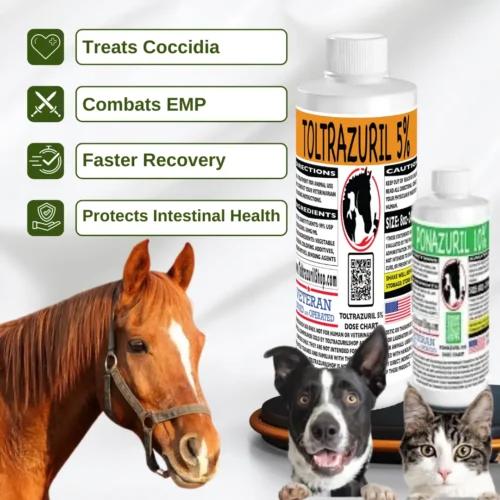-
Sale!

Toltrazuril EPM
$4.95 – $599.95Select options This product has multiple variants. The options may be chosen on the product page
Toltrazuril EPM
At Toltrazuril EPM, we provide a powerful and effective solution to prevent and treat coccidiosis across a wide variety of animal species. Our product is trusted by farmers, veterinarians, and pet owners alike for its reliable results and easy-to-administer application. Whether you’re dealing with poultry, livestock, or household pets, Toltrazuril EPM is designed to protect your animals from the harmful effects of coccidial infections.
What is Toltrazuril EPM?
Toltrazuril EPM is a highly effective antiparasitic treatment formulated to target and eliminate coccidia, a parasite that can cause serious health problems in animals. From cattle and poultry to dogs, cats, and exotic pets, this solution provides broad-spectrum protection against coccidiosis. The active ingredient in Toltrazuril works by disrupting the parasite’s ability to reproduce, offering relief to infected animals and helping to prevent future outbreaks.
Why Choose Toltrazuril EPM?
Proven Effectiveness: Toltrazuril EPM is a trusted solution for managing coccidiosis in a range of species. It is specifically designed to combat coccidia and support overall animal health, making it the go-to choice for treating and preventing infections.
Broad-Spectrum Use: Ideal for both small and large-scale use, Toltrazuril EPM is suitable for a variety of animals, including:
- Livestock: Calves, goats, sheep, and more
- Poultry: Chickens, turkeys, and other birds
- Companion Animals: Dogs, cats, and exotic pets
- Rabbits and Small Pets: Perfect for multi-pet households
Ease of Use: Available in multiple sizes and formulations, Toltrazuril EPM can be administered via drinking water or mixed with feed, ensuring a simple and convenient treatment process for any type of animal.
Veterinarian-Approved: Toltrazuril EPM is recommended by professionals in the field for its safety, efficacy, and quality. Our product is trusted to maintain animal health on farms, in veterinary practices, and in households.
Available Sizes and Packaging
We offer a variety of packaging options to meet your specific needs:
- Small Pet Use: 10 mL and 1 oz (30 mL) syringes for easy and precise dosing.
- Medium-Sized Operations: 4 oz (120 mL) and 8 oz (240 mL) bottles for larger groups of animals.
- Large-Scale Farms: 32 oz (960 mL), Half Gallon (64 oz), and 1 Gallon (128 oz) containers for substantial treatment coverage.
Each size is carefully designed to provide optimal dosing for the respective species, whether for individual animals or large herds and flocks.
How Toltrazuril EPM Works
Toltrazuril EPM is highly effective in treating coccidiosis by interfering with the parasite’s ability to reproduce. When administered, it helps eliminate the harmful parasite from the animal’s body, alleviating symptoms like diarrhea, lethargy, and weight loss. It also prevents future outbreaks, providing lasting protection for your animals.
The treatment is designed for easy oral administration—simply mix the solution into your animal’s feed or drinking water. Its powerful formula works quickly to restore your animals’ health, promoting overall well-being and reducing the risk of further infections.
Why Animal Health Matters
At Toltrazuril EPM, we understand that your animals are more than just livestock or pets—they are vital members of your family or business. That’s why we are committed to providing a trusted, high-quality solution for coccidiosis and other parasitic infections. Our focus is on offering products that support animal health and ensure your livestock or pets stay strong, productive, and happy.
Toltrazuril EPM is part of the Toltrazuril Shop family, a leader in providing reliable solutions for managing animal health. Toltrazuril Shop has been trusted by veterinarians, farmers, and pet owners for years, offering a wide range of high-quality treatments for coccidiosis and other parasitic infections. As part of this trusted network, Toltrazuril EPM ensures that your animals receive only the best care possible. Whether you’re looking for professional-grade treatments or easy-to-use solutions, Toltrazuril Shop has always been committed to offering high-quality products at competitive prices.
Order Toltrazuril EPM Today
Ready to protect your animals from the dangers of coccidiosis? Toltrazuril EPM is just a click away. Explore our product options today and choose the right size for your needs. With fast shipping, reliable customer service, and the quality you can trust, Toltrazuril EPM is here to help keep your animals healthy and thriving.
Have questions or need assistance? Our customer service team is here to help. Reach out to us for expert advice on using Toltrazuril EPM and how to best protect your animals from coccidia. We are always happy to provide support and ensure that your experience with our product is a positive one.
Protect your animals with the trusted solution—order Toltrazuril EPM today!